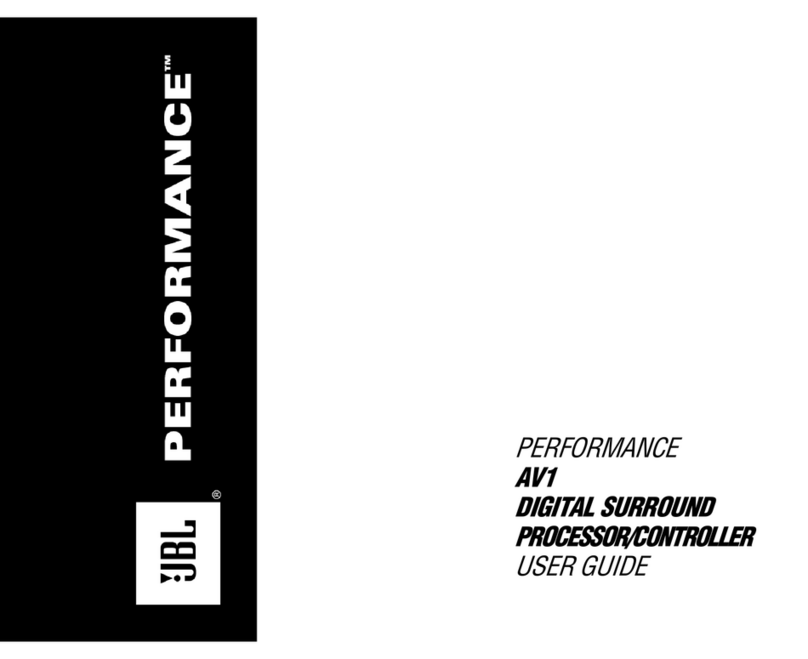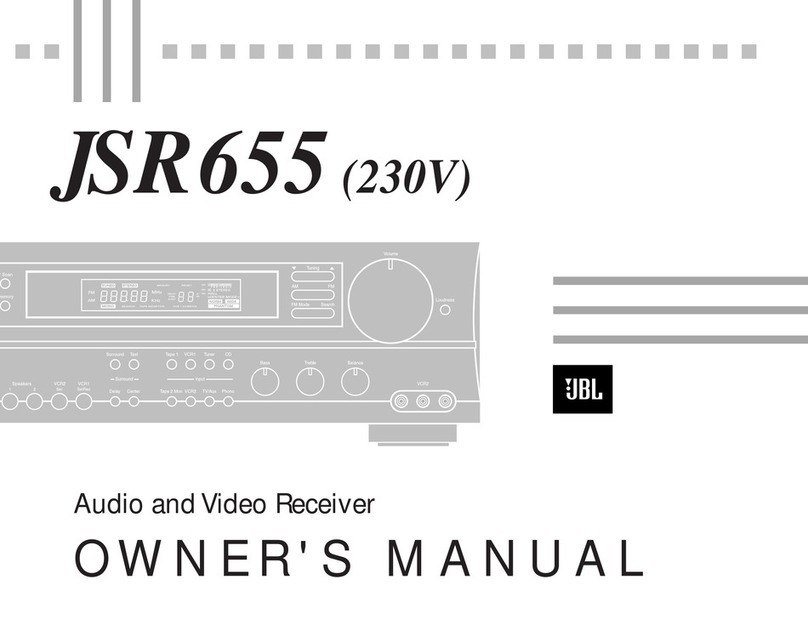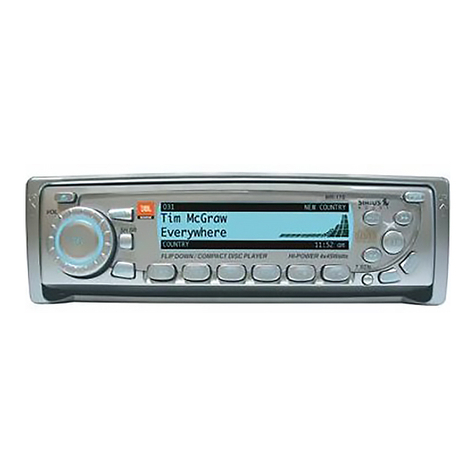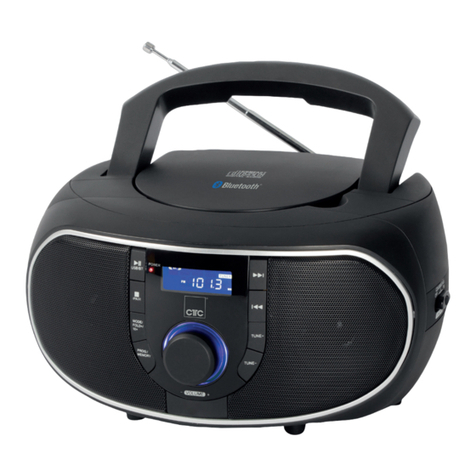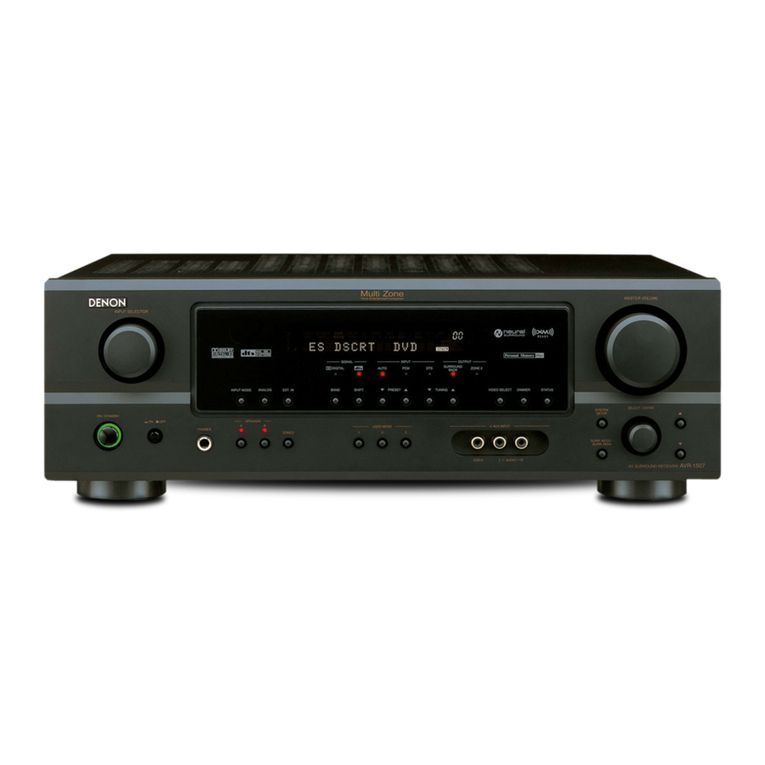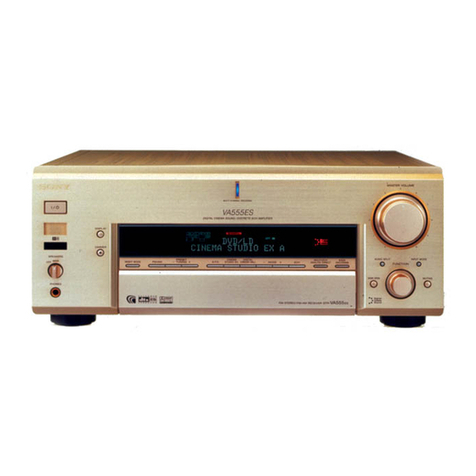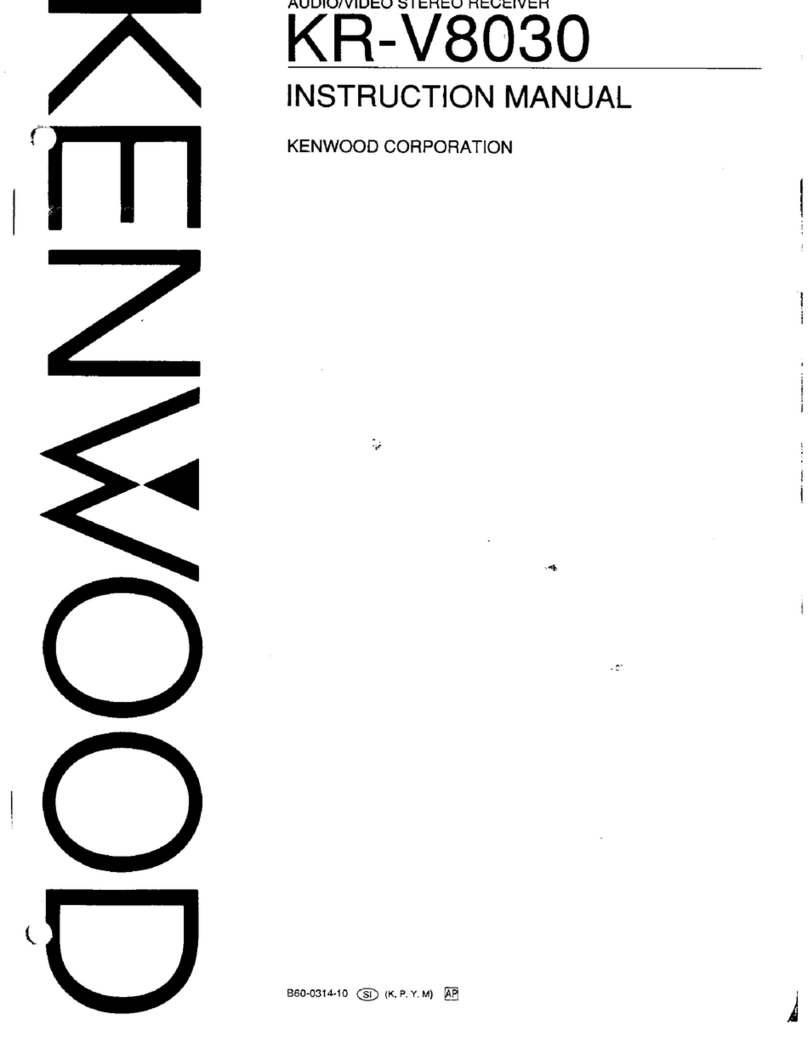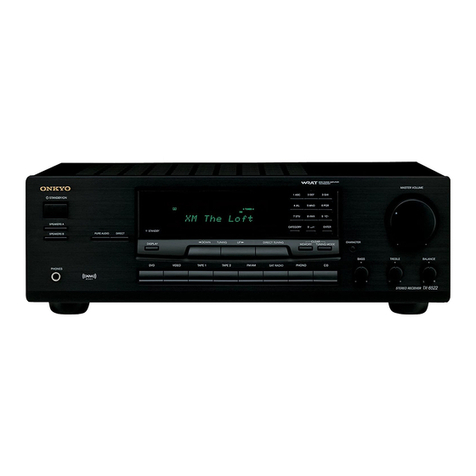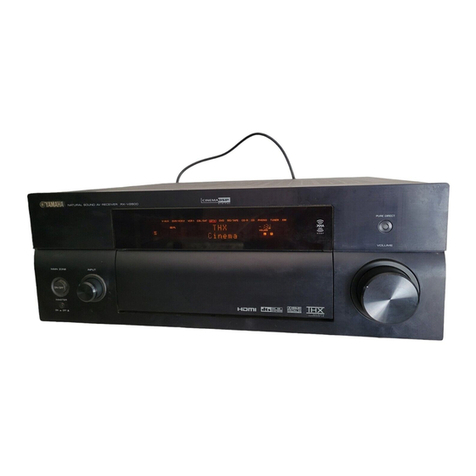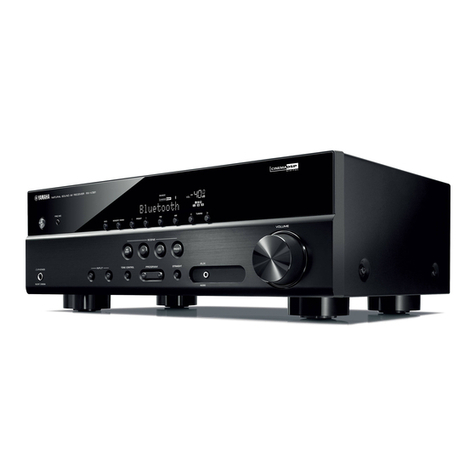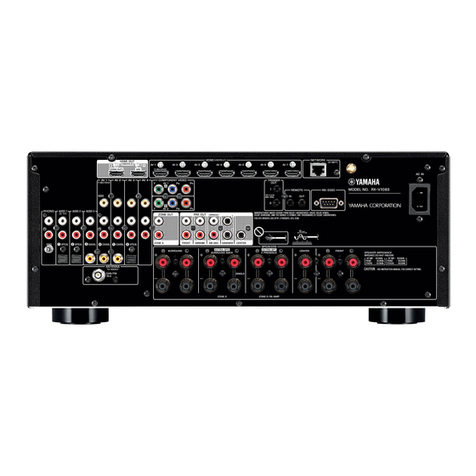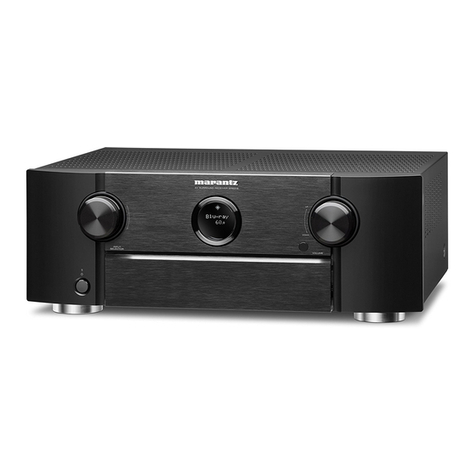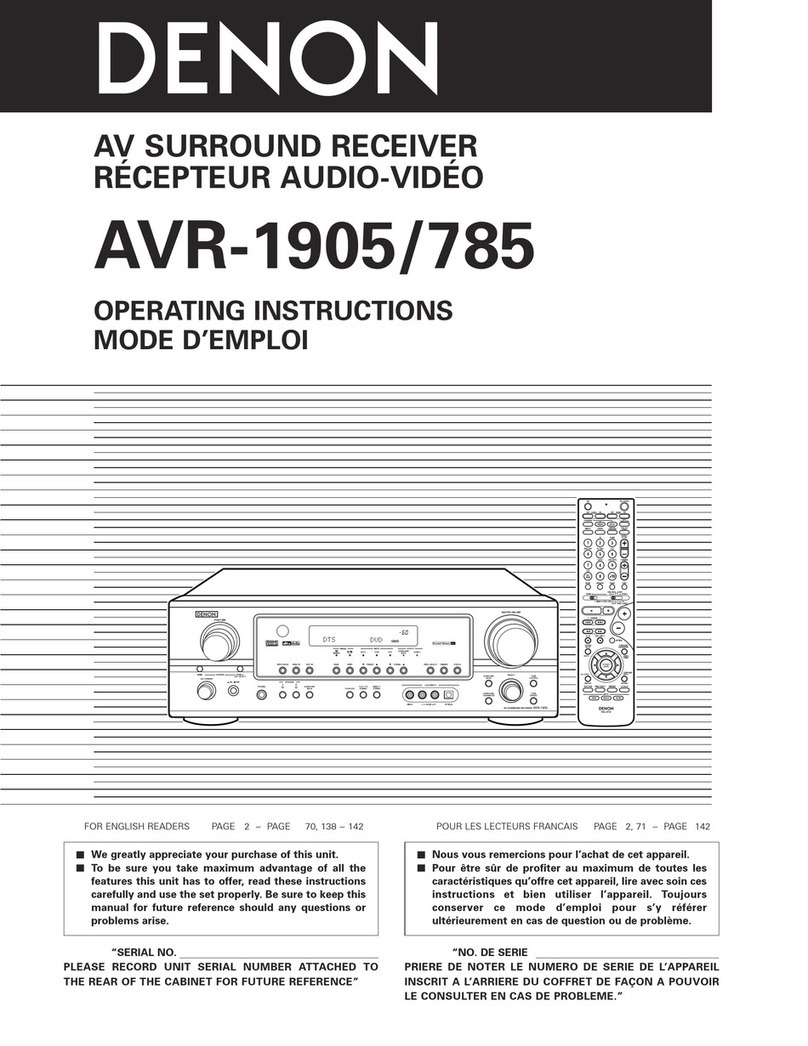JBL JSR675 User manual

JSR675(230V)
Audio andVideo Receiver
OWNER'S MANUAL
JSR675 OM (230V) 7/28/98 10:08 AM Page 2

CAUTION:
TO REDUCE THE RISK OF ELECTRIC SHOCK, DO NOT REMOVE
COVER (OR BACK). NO USER-SERVICEABLE PARTS INSIDE. REFER SERVICING
TO QUALIFIED SERVICE PERSONNEL.
WARNING:
TO REDUCE THE RISK OF FIRE OR ELECTRIC SHOCK, DO NOT
EXPOSE THIS APPLIANCE TO RAIN OR MOISTURE.
The lightning flash with arrowhead
symbol, within an equilateral triangle, is
intended to alert the user to the
presence of uninsulated “dangerous voltage”
within the product’s enclosure that may be of
sufficient magnitude to constitute a risk of electric
shock to persons.
The exclamation point within an
equilateral triangle is intended to
alert the user to the presence of
important operating and maintenance
(servicing) instructions in the literature
accompanying the appliance.
CAUTION
RISK OF ELECTRIC SHOCK
DO NOT OPEN
JBL JSR675
Date of purchase
Purchased from
Address of business purchased from
Installed by
Date installed
Serial no.
Thank you for choosing a JBL
Audio/Video Receiver.
Your new unit is an exceptionally well-
engineered product that will give you
years of superb performance.
Save all packing material.
It is essential for shipping should you
move, or in the event the unit ever
needs repair.
1
JSR675 OM (230V) 7/28/98 10:08 AM Page 3

2
Handle the Power Cord
Gently.
■To disconnect the plug from the
AC outlet, pull on the plug itself,
not on the cord.
■Disconnect the plug from the AC
outlet whenever the unit is to be
left unused for an extended
period of time.
■Do not place furniture or other
heavy objects on the cord, and
avoid dropping heavy objects on
it. Also do not make a knot in the
cord.
Place the unit on a firm
and level surface.
Avoid installing it:
■In moist or humid places
■Close to heating equipment or in
places exposed to direct sunlight
■In a direct draft from an air
conditioner or in other very cold
locations
■In places subject to excessive
vibration or dust
■In poorly ventilated places.
Moving the Unit.
Before moving the unit, be sure to
unplug the power cord from the AC
outlet and disconnect all wires from
antennas and other components.
Do Not Open the Cabinet.
Do not attempt to service this unit.
Tampering with internal components
can cause fire or shock, and may
void your guarantee. If water or small
objects enter the unit, unplug the
power cord immediately and consult
an authorized JBL service center.
Using the unit under such conditions
may cause a fire or shock hazard.
Cleaning.
Remove dust by wiping the unit with a
soft, dry cloth. If necessary, use a soft
cloth lightly dampened with mild
soapy water, then wipe with a dry
cloth. Never use benzene, thinner,
alcohol or other volatile agents, and
avoid spraying insecticides near
the unit.
TABLE OF CONTENTS
Front Panel Controls . . . . . . . . . . . . . . . . . . . . . . . . . . . . . . . . . . . . . . . . 3
Rear Panel Connections . . . . . . . . . . . . . . . . . . . . . . . . . . . . . . . . . . . . . 7
Optional Multi-Room Control Adapter Connection . . . . . . . . . . . . . . . . . .10
Surround-Sound Effects . . . . . . . . . . . . . . . . . . . . . . . . . . . . . . . . . . . . . .13
Operation . . . . . . . . . . . . . . . . . . . . . . . . . . . . . . . . . . . . . . . . . . . . . . . .15
JSR675 System Remote Control . . . . . . . . . . . . . . . . . . . . . . . . . . . . . . . .16
Troubleshooting . . . . . . . . . . . . . . . . . . . . . . . . . . . . . . . . . . . . . . . . . . . .18
Specifications . . . . . . . . . . . . . . . . . . . . . . . . . . . . . . . . . . . . . . . . . . . . .19
JSR675 OM (230V) 7/28/98 10:08 AM Page 4

3
Volume
Loudness
12 3 4 5 P. Scan
0-30
Memory67890
FM Mode Auto/Man
AM FM
Tuning
Power Speakers
12
VCR
2VCR
2Direct
Headphones Sel
Bass Treble Balance
DOLBY SURROUND
PRO•LOGIC
Surround Input
Center
Delay 3 Ch RecTape 2 Mon
VCR1Tape 1
VDP
VCR
2
TV/Aux
Tuner
Phono
CD
JSR675 DOLBY SURROUND RECEIVER
MHz
Tuned
FMST
FM
AM
VCR 1 REC
KHz
STADIUM
THEATER
SOURCE VDP VCR 2
DIRECT
DOLBY 3-CH
DOLBY SURROUND
AUTOTAPE 2 MON
PRESET
CENTER
MODE
NORM
WIDE
PHANTOM
PRO•LOGIC
MEMORY
MS
MIN
DELAY
TIME
SLEEP
729913
15
21 18 17 19 20 16 28 27 26
25
6542310 11 12 2282 24 143
1
Off Stadium TestPro Logic
Theater
Front Panel Controls
JSR675 OM (230V) 7/28/98 10:08 AM Page 5

4
1. POWER BUTTON
Press this button to turn the power
on. Press again to turn the power off.
It can also be used as a system
power button, if you connect the
other components to the switched
outlets.
NOTE: In POWER OFF state, the
POWER indicator will light up orange
and power is partially supplied to the
infrared remote control receiver and
the memory circuitry.
2. 1/2 SPEAKER SWITCHES
These switches allow you to select
various combinations of speakers as
follows:
■To play 1 pair of speakers, push
only the speaker 1 switch in.
■To play a second pair of speakers,
push only the speaker 2 switch in.
■To play both pairs of speakers,
push both 1 and 2 switches in.
■To use headphones for private lis-
tening or monitoring, leave both
1 and 2 switches pushed out.
NOTE: If both speaker switches
are pushed in and only one set of
speakers is connected to the
receiver, no sound will be heard.
3. HEADPHONE JACK
Stereo headphones can be plugged
into this jack for private listening.
Headphone impedance should be
between 8 and 2K ohms. Best results
will be between 200 and 400 ohms.
4. BASS CONTROL
Modifies the low-frequency sound of
the left and right channels as much
as ±10dB. Set this control at a suit-
able position for your taste and room
acoustics.
5. TREBLE CONTROL
Modifies the high-frequency sound of
the left and right channels as much
as ±10dB. Set this control at a suit-
able position for your taste and room
acoustics.
6. BALANCE CONTROL
This control is used for balancing the
relative sound volume of the left and
right channel speakers. Clockwise
rotation reduces the volume from the
left speaker, counterclockwise rotation
reduces the volume from the right
speaker.
7. SURROUND-OFF MODE
SELECTOR
Press this switch to select normal
stereo mode.
8. DELAY TIME
Adjusts time delay between front and
rear channels, operates only when
the surround mode is on. (See Delay
Time button on page 17.)
Adjusts the surround delay time in
steps. For Dolby Surround 20ms is
standard.
9. PRO LOGIC MODE
Press this button for PRO LOGIC
mode.
10. 3 CHANNEL MODE
The 3 channel mode can be used
when rear speakers are not being
used to provide a center (dialogue)
channel.
11. STADIUM/THEATER
MODE
Switches for selecting desired surround
mode; Stadium or Theater. (See
Surround-Sound Effects on page 13.)
16ms 18ms 28ms 30ms
.......
12. CENTER MODE
SELECTOR
This button operates only in DOLBY*
PRO LOGIC* and DOLBY 3 STEREO
mode. The mode changes as below,
when the button is pressed in suc-
cession.
DOLBY PRO LOGIC MODE
DOLBY 3 STEREO MODE
The display window shows each mode.
NORM: Select this mode if you use a
small center speaker. The bass
sound of the center channel is re-
produced from the front speakers,
because the small speaker cannot
produce enough bass.
WIDE: Select this mode if you use a
medium-to-large center speaker. The
bass sound is reproduced from the
center speaker.
PHANTOM: Select this mode if you
don’t use a center speaker. The
center speaker’s sound is reproduced
from the front speakers.
NORM WIDE
NORM WIDE PHANTOM
Front Panel Controls
JSR675 OM (230V) 7/28/98 10:08 AM Page 6

5
13. TEST TONE BUTTON
This button operates only in DOLBY
PRO LOGIC and DOLBY 3 STEREO
mode. When the button is pressed, 2
seconds of test tone is generated in
all channels (Left, Center, Right and
Surround) in succession. The display
window shows TEST Left, Center,
Right, and Rear in succession (in
DOLBY PRO LOGIC mode) or Left,
Center or Right in succession (in
DOLBY 3 STEREO mode). Use this
button to test speaker connections.
14. SOURCE/DIRECT
BUTTON
This feature bypasses the tone control
circuitry, resulting in flatter frequency
response and wider bandwidth. When
it is activated, DIRECT illuminates in
the display.
15. PRESET SCAN BUTTON
Press this button to scan the preset
station frequencies. The receiver stops
at each preset location that contains a
frequency for about 4 seconds, so you
can hear a station. The preset location
indicator blinks 4 times. Press this
button again to stop scanning.
16. SEARCH SELECTOR
Press this button to select AUTO or
MANUAL tuning.
■In AUTO mode, scanning is auto-
matically continued up or down
until the next station is picked up
by pressing the UP/DOWN tuning
buttons. The display window shows
AUTO. Use this mode to quickly
find strong AM or FM stations.
■In MANUAL mode, the frequency
is changed by a step with the
UP/DOWN button. If you keep
pressing the UP/DOWN tuning
buttons, scanning is continued
until the button is released.
NOTE: Tuning Intervals:
BAND EUROPE/AUSTRALIA
FM 50 kHz
AM 9 kHz
17. FM MODE BUTTON
Press this button to select stereo or
mono mode.
■STEREO: Provides stereophonic
reception of an FM stereo broad-
cast. The display window shows
FMST.
■MONO: The left and right channel
signals detected from an FM
stereo broadcast are mixed and
reproduced through both chan-
nels. If you want to find a weak FM
station, select this mode.
18. STATION MEMORY
BUTTON
Use this button to store an AM or FM
frequency. Press this button and
select one of 30 preset locations to
store the frequency with the STATION
PRESET buttons while the memory
indicator blinks MEMORY.
NOTE: When you store a frequency
in a memory location that already
contains a frequency, you replace the
previous frequency. If your receiver is
disconnected from AC power for
more than about 10 days, it loses all
stored frequencies.
19. UP/DOWN TUNING
BUTTONS
Press the DOWN button ▼to tune in
lower frequency stations, the UP
button ▲to tune in higher frequency
stations. If you press the DOWN
button when the display is at the
bottom of the frequency range, the
display returns to the top of the
range. If you press the UP button
when the display is at the top of the
frequency range, the display returns
to the bottom of the range. When the
receiver finds a strong frequency, the
display window shows TUNED.
20. FM/AM BAND SELECTOR
Press these buttons to select the FM or
AM radio band. When you select the AM
or FM radio band, the receiver displays
the last frequency selected on that band.
JSR675 OM (230V) 7/28/98 10:08 AM Page 7

6
21. STATION PRESET
BUTTONS
Select one of 30 preset locations to
recall the station stored in memory. The
input function is automatically changed
to TUNER when the button is pressed.
When you select numbers from 10
through 29, you must select the second
digit within about 2 seconds. To select
preset 30, simply press 0.
22. TAPE 2 MON BUTTON
Set TAPE 2 MONITOR button to the “off”
position when you want to hear the other
input functions. Press this button to
monitor the cassette deck connected to
the TAPE 2 MON input jacks.
23. INPUT FUNCTION
SELECTOR
Press the button to select the desired input
function: VCR 1, VCR 2, VDP, TAPE 1,
TV/Aux, Tuner, CD or Phono.
To dub from VCR 2 to VCR 1, press the
VCR 2 button and then press the VCR 1
REC button.
For the input function of VCR 1 press
the VCR 2 button and VCR 1 DUBBING
button. Set the recording VCR (VCR 1)
to recording mode. Set the playback
VCR (VCR 2) to play a tape.
Dubbing will start.
■To hear another input source during
videotape dubbing: Press the input
function you want to hear, and play
the input source.
NOTE: If you press the TEST TONE
button during VCR 1 DUBBING, the
audio signal is not recorded.
24. VCR 2 SELECTOR
Push in this button to select the VCR 2
jacks on the front, rather than the VCR 2
jacks on the rear.
25. VCR 2/CAMCORDER
INPUT JACKS
VIDEO IN:
Connect to the VIDEO OUTPUT jack of a
VCR (Yellow jack).
AUDIO IN:
Connect to the AUDIO OUTPUT jacks of a
VCR (Red and White jacks).
26. LOUDNESS BUTTON
Press this button to compensate for the
response of the human ear at low listening
levels (known as the Fletcher-Munson
hearing curve). The high and low frequen-
cies are automatically boosted when this
button is pushed in. In the OFF position,
the frequency response is flat at all
volume levels. This button does not work
at high volume levels.
27. VOLUME CONTROL
Turn the VOLUME clockwise to
increase the volume and counter-
clockwise to decrease it. The vol-
ume of the front, center, and rear
channels is changed at the same
time.
28. VOLUME LEVEL
INDICATOR
This indicator moves in accordance
with the volume level. The indicator
blinks when the mute button on the
remote commander is pressed.
29. DISPLAY WINDOW
This window shows the state of
operation for easier control of the
receiver. It also contains the IR
Remote Sensor.
JSR675 OM (230V) 7/28/98 10:08 AM Page 8

7
Rear Panel Connections
PHONO CD
GND
TAPE1
ANTENNA
REMOTE SERIAL NO.
MONITORS
FM
75 ΩAM
LOOP
VCR 2VCR 1 VDP
AUX TAPE 2 MON
RL
REMOTE
AUDIO
PLAY
VIDEO
OUT OUT
OUT
IN
L
R
VCR-2
IN
3
57
17
18
23
6
1
2
8 9 10 11
CENTER
SPEAKER
VCR
PLAY ONLY VCR or VDP
12 13
15
AM LOOP ANTENNA
FM OUTDOOR
ANTENNA
FM INDOOR ANTENNA
TV MONITOR 1
REAR SPEAKERS
FRONT SPEAKERS 1
TV MONITOR 2
SUBWOOFER
AMPLIFIER (FOR SUBWOOFER)
-
-
+
-
+
-
+
+
RIGHT LEFT
300Ω/75Ω
ADAPTOR 300Ω/75Ω
ADAPTOR
21
4
TURNTABLE
COMPACT DISC PLAYER
CASSETTE DECK 1
TO
TO WALL
OUTLET
TO WALL OUTLET
TO WALL OUTLET
CASSETTE DECK 2
FRONT SPEAKERS 2
TO WALL OUTLET
-
+
-
++
-
REC
IN
PLAY
OUT REC
IN
PLAY
OUT
IN OUT OUT
AUDIO VIDEO
LEFT
RIGHT PLAY REC PLAY REC PLAY REC
IN OUT FRONT SPEAKERS
AC OUTLET
SWITCHED
230V–50Hz
100 W MAX
230V 50Hz
650W
REAR SPEAKERS 8Ω
-1
-2
RIGHT LEFT
USE 4 OHM MIN. SPEAKERS
MODEL NO.: JSR675
JBL INCORPORATED
NORTHRIDGE
CALIFORNIA, USA
MADE IN KOREA
SUBWOOFER
OUT
PRE OUTPRE OUTPRE OUTMAIN IN
LEFT
RIGHT
CENTER REARFRONT RIGHT
LEFT
22
20
21
23
16
CENTER SPEAKER
19
12 13
14
JSR675 OM (230V) 7/28/98 10:08 AM Page 9

8
1. FM INDOOR ANTENNA
Connect the supplied antenna (the
wire lead) to a 300Ω/75Ωadapter
and connect the adapter to the 75Ω
FM antenna terminal, as shown in the
Rear Panel Connection Diagram.
Change the position of the antenna
until you get the best reception of
your favorite stations.
2. FM OUTDOOR
ANTENNA
An outdoor FM antenna may be used
to further improve the quality of
reception. Disconnect the indoor
antenna before replacing it with the
outdoor one. A 75Ω/300Ωadapter
must be used.
3. AM LOOP ANTENNA
Tune in your favorite AM station and
position the loop antenna for best
reception. Try other stations and find
the position that gives the best overall
reception. When this unit is mounted
in a rack or placed on a shelf with
insufficient space behind, hang the
antenna on a wall in the direction
which gives the best reception.
NOTE: If noise is heard during AM
reception, move the antenna for bet-
ter reception. To prevent undesired
noise, the AM LOOP ANTENNA
should be located at least 12 inches
(30cm) away from the remote control
wires.
4. SYSTEM GROUND
TERMINAL
To reduce hum to a minimum, connect
the ground lead from your turntable to
this terminal.
5. PHONO INPUT JACKS
Input for a TURNTABLE with an MM
cartridge requiring a 47K ohm of load
impedance. Connect shielded cables
from your phono to the LEFT and
RIGHT input jacks.
NOTE: Do not place your
TURNTABLE on a speaker enclosure.
This will avoid howling caused by
transmission of the speaker vibration
to the TURNTABLE.
6. TV/AUX INPUT JACKS
This extra stereo input is provided for
any source you want to hear. An
additional compact disc player, a
tape recorder, a video cassette
recorder (VCR) etc., can be plugged
into these jacks.
7. CD INPUT JACKS
Connect the output cables of a
compact disc player to these jacks.
8. TAPE 1 PLAY JACKS
Connect the line output of your
CASSETTE DECK to these jacks.
9. TAPE 1 REC JACKS
Connect the line input of your
CASSETTE DECK to these jacks.
10. TAPE 2 MONITOR
PLAY JACKS
Connect the line output of your
CASSETTE DECK to these jacks. This
input may be connected to the line
output of the audio processor like an
optional graphic equalizer or a Digital
Signal Processor.
11. TAPE 2 MONITOR REC
JACKS
Connect the line input of your
CASSETTE DECK to these jacks. EQ
controls, loudness and volume settings
have no effect on the signal from this
output for recording. To monitor this
input source while recording, press the
TAPE 2 MON button (MONITOR ON
position). These REC jacks may be
used for the line input of the audio
processor like an optional graphic
equalizer or a Digital Signal Processor.
AM LOOP ANTENNA SETTING
Stand and place it on a shelf
or hang it on a wall.
LEG
Rear Panel Connections
JSR675 OM (230V) 7/28/98 10:08 AM Page 10

9
12. VIDEO/AUDIO INPUT
(PLAY) JACKS OF VCR 1
Connect these jacks to the corre-
sponding AUDIO OUTPUT jacks of
your VCR.
13. VIDEO/AUDIO OUTPUT
(REC) JACKS OF VCR 1
Connect these jacks to the corre-
sponding INPUT jacks of a VCR.
VIDEO OUTPUT jack: Connect this
jack to the VIDEO INPUT jack of the
VCR. AUDIO REC jack: Connect
these jacks to the AUDIO INPUT
jacks of the VCR.
14. VIDEO/AUDIO INPUT
(PLAY) JACKS OF VCR 2
Connect these jacks to the corre-
sponding OUTPUT jacks of your VCR
or VDP.
15. VIDEO MONITOR JACK
Connect this jack to the VIDEO
INPUT jack of a TV/MONITOR.
16. REMOTE OUT JACK
Connect this jack to the REMOTE IN
jack on a Harman Kardon component.
Use one of the accessory mini-plug
cables.
You can control some Harman Kardon
components in your system using the
JSR675 remote commander.
17. MULTI-ROOM REMOTE
IN JACK
Connect a remote IR sensor to this
jack. You can operate the unit by
remote commander through the
adapter. It is convenient when the unit
is located in a separate room. (See
page 10)
18. FRONT, CENTER, REAR
PRE OUT AND MAIN IN
JACKS
FRONT PRE OUT
When a separate power amplifier is
used to drive the front speakers,
connect the power amplifier input to
these jacks.
FRONT MAIN IN
When a separate pre-amplifier is
connected and this unit is used as a
power amplifier, connect the pre-
amplifier output to these jacks.
NOTE: When you do not use the
PRE OUT and MAIN IN separately,
always connect the PRE OUT and
MAIN IN jacks with a jumper plug.
CENTER PRE OUT
When a separate power amplifier is
used to drive the center speaker,
connect the power amplifier input to
these jacks.
REAR PRE OUT
When a separate power amplifier is
used to drive the rear speaker, con-
nect the power amplifier input to
these jacks.
19. SPEAKER TERMINALS
(1, 2 and CENTER)
Connect the main left (L) and right (R)
speakers to the corresponding 1 and 2
speaker terminals. Connect the center
speaker to the center (+), (-) terminals.
Make sure that the positive (+) and
negative (-) terminals on the speaker
are connected to the corresponding
terminals on the receiver.
20. REAR SPEAKER
TERMINALS
Connect rear speakers to the
corresponding terminals.
21. AC INPUT CORD
Plug this cord in AC outlet on a wall.
22. SUBWOOFER OUT
When a powered subwoofer or
separate power amplifier is used to
power a subwoofer connect these
jacks to the input of the amplifier (for
subwoofer or powered subwoofer).
23. AC SWITCHED OUTLET
This outlet provides AC power. The
AC power is switched by the power
button. Use this outlet for a source
component, such as a CD player.
JSR675 OM (230V) 7/28/98 10:08 AM Page 11

10
REMOTE CONTROL
REMOTE
REMOTE ROOMMAIN ROOM
REMOTE
COMMANDER
2 SPKR
LEFT
1 SPKR
LEFT 1 SPKR
RIGHT 2 SPKR
RIGHT
REMOTE IR SENSOR
RECEIVER
IN
LEFT
RIGHT
OUT
MAIN IN PRE OUT PRE OUTPRE OUT
LEFT
RIGHT
CENTER
FRONT REAR
SUBWOOFER
OUT
Volume
Loudness
12 3 4 5 P. Scan
0-30
Memory67890
FMMode Auto/Man
AM FM
Tuning
Power Speakers
12
VCR2 VCR2Direct
Headphones Set
Bass Treble Balance
DOLBYSURROUND
PRO•LOGIC
Surround Input
Theater
Stadium
Center
Test
Delay
Off
3Ch
ProLogic
RecTape2 Mon
VCR1Tape1
VDP
VCR2
TV/Aux
Tuner
Phono
CD
JSR675DOLBY
®
SURROUND RECEIVER
MHz
Tuned
FMST
FM
AM
VCR1REC
KHz
STADIUM
THEATER
SOURCE VDP VCR2
DIRECT
DOLBY3-CH
DOLBYSURROUND
AUTOTAPE2MON
PRESET
CENTER
MODE
NORM
WIDE
PHANTOM
PRO•LOGIC
MEMORY
MS
MIN
DELAY
TIME
SLEEP
REMOTE IR SENSOR
CD
Tape1
Tape2
TV/AuxVDP
VCR1
VCR2
CassDeck
Skip
Intro
Search
Phono
Tuner A-B
A/B
Select
Delay
Off
Theater
Stadium
Surround
3-Stereo
Pro-Logic
Display
Sleep
Mute
RearLevel
MasterVolume
CenterLevel CentMode Test
Power
Tuning
PScan
Tuner
CD
1
23
45
6
7
89
0
%
%
&
&
#
$
-*
*
+
+
Disc
Optional Multi-Room Control
Adapter Connection
JSR675 OM (230V) 7/28/98 10:08 AM Page 12

11
(Remove PRE OUT/MAIN IN jumpers when the front speakers are connected to external amplifier.)
RL
LINE-IN
L
R
FRONT(left)
FRONT(right)
Power
Power Amplifier
MAIN IN PRE OUT PRE OUTPRE OUT
LEFT
RIGHT
CENTER
FRONT REAR
USE 8 OHM MIN SPEAKERS
FRONT SPEAKERS
REAR SPEAKERS 8Ω
CENTER SPEAKER
-1
-2
RIGHT LEFT
When you drive the front speakers with another amplifier:
JSR675 OM (230V) 7/28/98 10:08 AM Page 13

12
RL
MAIN IN PRE OUT PRE OUTPRE OUT
LEFT
RIGHT
CENTER
FRONT REAR
USE 8 OHM MIN SPEAKERS
FRONT SPEAKERS
REAR SPEAKERS 8Ω
CENTER SPEAKER
-1
-2
RIGHT LEFT
FRONT SPEAKER
CENTER
SPEAKER
LINE-IN
L
R
FRONT(left)
FRONT(right)
Power
Power Amplifier
JUMPER PLUG
When you drive the rear speakers with another amplifier:
JSR675 OM (230V) 7/28/98 10:08 AM Page 14

13
Surround Sound
The JSR675 is equipped with 4 types
of surround processors (DOLBY PRO
LOGIC, DOLBY 3 STEREO, THEATER
and STADIUM) which provide a
sense of presence and expansion
and let you enjoy surround-sound in
your home.
Every day, we are exposed to sounds
coming from our surroundings. Some
sounds reach our ears directly from
the source, some indirectly reflected
by walls or ceilings. Sounds of voices
reach us from behind, sounds of cars
reach us from the side. Sounds com-
ing from all around us are called
surround-sounds.
In order to re-create with as much
precision as possible that special
sound in movie theaters, speakers
are placed both in front of and
behind the listeners. One reason that
sound from the television in our
homes is so different from sound in
movie theaters is because usually
sound from a television only comes
from in front of the viewer. With a
surround system, the sounds of
applause and cheers from the stands
during a baseball game on TV come
from in front and in back, from left
and right.
The sound from a TV equipped with
a single speaker (or 2 speakers with
stereo televisions) sounds very differ-
ent from the actual “live” sound.
Surround Processors
- THEATER/STADIUM
These modes works best for recorded
concerts and other music programs.
In their modes, the front speakers
provide a normal stereo effect while
the rear speakers provide a reverber-
ated sound. This reverberation helps
simulate the sound you might hear at
a live concert.
- DOLBY 3 STEREO
Combining the front and rear signals
so that you can enjoy a regenerated
sound field which has comparatively
more presence and a more expansive
feeling from the front 3 channels (front
L, front R, center speakers) than that
of ordinary stereo regeneration.
- DOLBY PRO LOGIC SURROUND
A great number of movies made in
recent times have the soundtrack
specially encoded with the Dolby
Surround mode (carrying the Dolby
Stereo or Dolby Surround trademark).
The front speakers provide the dia-
logue and the normal stereo effect,
while the rear speakers reproduce the
surround signals. This position pro-
vides excellent results when watching
television programs, video software,
video discs or videotapes of stereo
television broadcasts encoded with
Dolby Surround. Dolby Stereo films
have dramatically changed the role of
the moviegoer from that of observer to
that of participant. Clearer dialogue,
richer music, enveloping ambience
on-screen, and making high-fidelity
multidimensional sound are essential
parts of cinematic presentations.
Imagine re-creating the same sort of
audio-visual experience right in your
own home.
*Manufactured under license from Dolby Laboratories
Licensing Corporation.
DOLBY, the double-D symbol and PRO LOGIC are
trademarks of Dolby Laboratories Licensing Corporation.
Speaker Installation
The JSR675 incorporates a decoder
which reproduces the specially
encoded surround-sound of Dolby
Surround video programs. In Dolby
Surround mode, select the speaker
operation mode according to your
speaker system.
NORMAL mode
Select this mode if you use a small center speaker. The bass
sound of the center channel is output from the front speakers,
as a small speaker can’t produce enough bass.
CENTER
FRONT
(left) FRONT
(right)
REAR
(right)
REAR
(left)
Surround-Sound Effects
JSR675 OM (230V) 7/28/98 10:08 AM Page 15

14
FRONT
(right)
FRONT
(left)
FRONT
(left)
CENTER
FRONT
(right)
REAR
(right)
REAR
(left)
FRONT
(left) FRONT
(right)
CENTER
REAR
(right)
REAR
(left)
WIDE mode
Select this mode if you use a medium to big center speaker. PHANTOM mode
Select this mode when you play back a Dolby surround
program source without using a center speaker. The
sound of the center channel is output from the front
(L and R) speakers.
3 STEREO mode
Select this mode when you play back a Dolby surround
program source only with the front and center speak-
ers. The sound of the rear channel is output from the
front (L and R) speakers.
JSR675 OM (230V) 7/28/98 10:08 AM Page 16

15
TUNER SECTION
- Press the FM/AM SELECTOR on the
front panel.
- Three different ways can be selected
for tuning.
A. SEARCH TUNING
If signals are strong and there is no
interference, quick auto search
tuning is possible.
1. Press the AUTO/MAN button so
that the indicator AUTO lights up.
2. Press the TUNING button (DOWN
or UP) to tune. Tuning will start
automatically and stop at a broad-
cast station frequency with suffi-
cient signal strength.
B. MANUAL TUNING
Auto tuning may be impossible if the
station signal is weak. If so, use man-
ual searching.
1. Press the AUTO/MAN selector so
that the indicator AUTO goes off.
2. Press the TUNING button (DOWN
or UP) to tune. The frequency will
change rapidly if the TUNING
button is kept pressed. Release it
slightly before reaching the desired
frequency, and press it intermittently
until the desired frequency is
reached.
C. PRESET TUNING
STATIONS
PRESET buttons can be used to
select any desired station which has
been preset. To preset a station in
memory:
1. Tune to the station to be memorized.
2. Press the MEMORY button and
press the desired preset station but-
ton while the memory indicator blinks
(it will blink for about 4 seconds). To
recall the preset station, press the
desired STATION PRESET buttons. If
pressing only one numeral, there will
be a 4-second delay until the preset
is recalled.
AMPLIFIER SECTION
1. Set the VOLUME CONTROL to the
extreme counterclockwise position.
2. Turn the power on.
3. Select the desired input function.
4. Play the input source.
5. Turn the VOLUME clockwise until
you reach the desired sound level.
TAPE RECORDING
1. Insert a blank tape in a cassette
deck (TAPE1 or TAPE2).
2. Select the desired input function.
3. Set the cassette deck to recording
mode.
4. Play the input source. Recording will
start.
TAPE DUBBING
1. Insert a blank tape in cassette deck 2
(TAPE2).
2. Insert a recorded tape in cassette
deck 1 (TAPE1).
3. Select the input function of TAPE2
MON to monitor the sound (see #11
on page 8).
4. Set cassette deck 2 to recording
mode.
5. Set cassette deck 1 to playback
mode. Dubbing will start.
NOTE: If you press the TEST TONE
button during TAPE RECORDING or
TAPE DUBBING, the audio signal is not
recorded.
PROTECTION CIRCUITS
This receiver has special protection
circuits.
■The thermal overload protection
circuit automatically turns off the
power if it begins to overheat.
■The overdrive protection circuit
automatically turns off the power if it
is about to deliver too much power.
■The short protection circuit auto-
matically turns off the power if the
speaker terminals are shorted.
If the receiver shuts off, check to be
sure that the ventilation holes on the top
of the receiver are clear of obstructions,
and check the speaker connections
and impedance.
Operation
JSR675 OM (230V) 7/28/98 10:08 AM Page 17

16
1. INFRARED TRANSMITTER
WINDOW
The internal beam is emitted forward from
this window when you press any button
on the commander. For the remote con-
trols to function properly, always face this
window toward the remote sensor window
on the receiver and do not obstruct this
window with any material.
2. POWER BUTTON
Press this button to turn the power on and
off. Automatic power on: When you press
the input function buttons (CD, TUNER,
TAPE 1, TAPE 2, TV/AUX, VCR 1, VCR 2,
PHONO) in STANDBY mode, the power is
automatically turned on and the function is
selected.
3. TUNING UP/DOWN
Press these buttons to tune the receiver
up or down.
1
12
4
5
6
16
14
11
2
3
7
13
15 17
8
CD
Tape1 Tape2
TV/Aux
VDP
VCR1 VCR2
CassDeck
Skip
Intro
Search
Phono
Tuner A-B
A/B
Select
Delay
Off
Theater
Stadium
Surround
3-Stereo
Pro-Logic
Display Sleep Mute
RearLevel MasterVolume
CenterLevel CentMode Test
Power Tuning PScan
Tuner
CD
12345
67890
%
%
&
&
#$
-*
*
+
+
Disc
18
9
10
REMOTE CONTROL
OPERATION RANGE
Volume
Loudness
12 3 4 5 P.Scan
0-30
Memory67890
FM Mode Auto/Man
AM FM
Tuning
Power Speakers
12
VCR2 VCR2Direct
Headphones Sel
Bass Treble Balance
DOLBY SURROUND
PRO•LOGIC
Surround Input
Theater
Stadium
Center
Test
Delay
Off
3 Ch
Pro Logic
RecTape 2 Mon
VCR1Tape 1
VDP
VCR2
TV/Aux
Tuner
Phono
CD
JSR675 DOLBY SURROUND RECEIVER
MHz
Tuned
FMST
FM
AM
VCR1 REC
KHz
STADIUM
THEATER
SOURCE VDP VCR 2
DIRECT
DOLBY3-CH
DOLBYSURROUND
AUTOTAPE2 MON
PRESET
CENTER
MODE
NORM
WIDE
PHANTOM
PRO•LOGIC
MEMORY
MS
MIN
DELAY
TIME
SLEEP
30
0
30
0
8m
CD
Tape1
Tape2
TV/AuxVDP
VCR1
VCR2
CassDeck
Skip
Intro
Search
Phono
Tuner A-B
A/B
Select
Delay
Off
Theater
Stadium
Surround
3-Stereo
Pro-Logic
Display
Sleep
Mute
RearLevel
MasterVolume
CenterLevel CentMode Test
Power
Tuning
PScan
Tuner
CD
1
23
45
6
7
89
0
%
%
&
&
#
$
- *
*
+
+
Disc
JSR675 System Remote Control
JSR675 OM (230V) 7/28/98 10:08 AM Page 18

17
4. PRESET SCAN BUTTON
Button for scanning preset station
frequencies (see page 15).
5. NUMERIC BUTTONS
These buttons can be used for preset
tuning in TUNER mode. Preset tuning:
Press the TUNER button to change the
input function of the receiver to TUNER
and then select one of the 30 preset
locations.
6. CD FUNCTION BUTTONS
For a CD PLAYER: DISC (DISC SKIP,
this is available for Harman Kardon CD
changers), (play), (pause), (stop), (back-
ward skip), (forward skip), 1-2 and
INTRO buttons are available. When
selecting a disc, press the DISC button.
The A-B button is used to repeat a
specific passage.
7. CASSETTE DECK
FUNCTION
BUTTONS - For a cassette deck:
(pause/record), (stop), (record),
(reverse play), (forward play), (rewind),
(fast forward) buttons are available.
This will only work with some Harman
Kardon cassette decks.
8. DELAY TIME BUTTON
This button operates only in DOLBY
PRO LOGIC and THEATER/STADIUM
modes. In these modes, the output
signal from the surround speakers is
delayed slightly from that of the front
speakers. Select appropriate delay
time to achieve the best surround
sound effect. For Dolby Surround
sound, we recommend a 20ms delay.
The time is changed as below, when
the button is pressed in succession.
DOLBY PRO LOGIC
THEATER/STADIUM MODE
9. INPUT FUNCTION
SELECTOR
Press the button to select the desired
input function. The available buttons
are CD, TUNER, TAPE 1, TAPE 2,
TV/AUX, VCR 1, VCR 2, and PHONO.
10. CENTER LEVEL
UP/DOWN BUTTONS
Use these buttons to adjust the sound
level of the center speaker to that of the
front speakers. These buttons work only
in DOLBY PRO LOGIC and DOLBY 3
.......
8ms 16ms 88ms 96ms
16ms
24ms 26ms 28ms 30ms
18ms 20ms 22ms
STEREO mode. These buttons do not
work in PHANTOM mode.
11. CENTER MODE BUTTON
Selects the center mode (see page 14).
12. TEST TONE BUTTON
Generates test sounds in all channels
(Left, Center, Right and Surround) in
succession.
13. REAR LEVEL UP/DOWN
BUTTONS
These buttons operate only in DOLBY
PRO LOGIC THEATER and STADIUM
mode. Use these buttons to adjust
the sound level of the surround
speakers. Set the MASTER VOLUME
control at the desired level and press
the up or down button until you get
the optimum surround effect at your
listening position.
14. MASTER VOLUME
BUTTONS
Adjust the overall (front, center, and
rear) volume level.
15. DISPLAY BUTTON
Press once and the display dims,
press again and it turns off. Press a
third time and it goes on.
16. SLEEP BUTTON
Sets the receiver to automatically turn
off after 10, 20, 30, 60, or 90 minutes.
Each time the button is pressed, the
setting is advanced as below.
The display will dim when the sleep
function has been set.
17. MUTE BUTTON
Press this button to silence the
speakers temporarily. The volume
indicator blinks. Press again to
restore the same listening level as
before.
18. BATTERY
COMPARTMENT
This battery case is provided as the
power source for the commander. To
remove the cover, press it down with
your thumb and pull it toward the
back side. Two UM-3, size “AA” or R6
1.5V dry batteries are used. When
loading the batteries, make sure that
the polarity is correct. Remove the
batteries from the case if the remote
commander will not be used for a
long time.
10 min 20 min 30 min 60 min 90 min OFF
JSR675 OM (230V) 7/28/98 10:08 AM Page 19

18
This unit is designed for trouble-free operation. Most problems users encounter are due to operating errors. So if you have a problem, first check this list for a possible
solution. If the problem persists, consult your authorized JBL service center.
If the problem is... Make sure that the:
No lights illuminate when Power switch is pressed. • Unit is plugged into a live outlet.
No sound is heard. • Speaker selector is set to the desired speakers.
• Correct source button has been pressed.
• Volume is turned up.
• Speakers are connected properly.
Dolby Surround does not work on center and rear channels. • Correct surround mode is selected.
• Rear and Center levels are turned up.
Selecting video component produces sound but no picture. • Video cables are connected properly.
The TV picture does not match the sound. • Video sources are properly connected to receiver.
• Video/Antenna Switch on TV is set to Video.
No output from one or more channels. • Cables are not defective: check/replace speaker or phono cables.
• The signal source is operating and providing proper signal output to the JSR675.
No center channel output. • Dolby surround or movie mode is turned on.
• “Phantom” mode is not active.
Tuner sound has a large amount of interference. • The antenna is properly connected.
OR, The “Stereo” display is not fully illuminated. • The antenna is properly located.
OR, Tuner sound distorts and/or volume level is too low. • The antenna is set in the proper direction.
• The antenna is adequate to receive the desired station.
Tuner is intermittent or continuously buzzing or hissing. • The unit is away from fluorescent lights, TVs, motors and other electrical appliances.
Stations cannot be preset. • After pressing the Memory button, the Preset button is pressed while the “Memory” light is still flashing.
Phono sound is too faint, has hum, ringing, or howl. • Turntable cartridge is moving magnet type or step-up transformer is used.
• Ground wire from turntable has been connected to ground terminal on receiver.
• Cable from turntable is away from power cords and speaker cables.
• Turntable is away from speakers.
• Turntable is on a stable surface.
Troubleshooting
JSR675 OM (230V) 7/28/98 10:08 AM Page 20

19
Stereo Mode
Continuous Average Power 150 Watts x 2, 8 Ohms
Five Channel Surround Mode
Continuous Average Power
Front L&R channels 130 Watts x 2, 8 Ohms
Center channels 130 Watts, 8 Ohms
Rear channels 40 Watts x 2, 8 Ohms
Amplifier Section
High-Instantaneous Current Capability
(HCC): ±40 Amps
Negative Feedback: 26dB
Frequency Response @ 1W (+0/-3dB): 0.5Hz - 150kHz
Slew Rate: 80 Volts/µSec
Rise Time: 1.8µSec
Transient Intermodulation Distortion (TIM): Unmeasurable
Preamplifier Section
Signal-to-Noise Ratio (ref. 1 Volt, A-Wtd)
Phono (MM): 74dB
CD: 92dB
Video: 84dB
Input Sensitivity/Impedance
Phono (MM): 2,5mV/47kΩ125pF
Video, CD, Tape: 150mV/22kΩ
Phono Overload: 120mV
RIAA EQ Accuracy (20Hz-20kHz): ±1.0dB
Tone Control Range
Bass @ 100Hz: ±10dB
Treble @ 10kHz: ±10dB
Loudness Contour
100Hz/10kHz: +6dB/+3dB
Tuner Section: FM
Usable Sensitivity, Mono (dBf); 11.2
50dB Quieting Sensitivity, Stereo (dBf): 37.2
Signal-to-Noise Ratio
@ 65dBf, mono/stereo: 74dB/70dB
Capture Ratio: 1.5dB
Selectivity, Adjacent/Alternate Channel: 5dB/65dB
IF Rejection: 100dB
AM Rejection @ 45dBf: 55dB
Stereo Separation @ 1kHz, 65dBf: 45dB
THD @ 1kHz, 65dBf, mono/stereo (%): 0.2/0.3
Tuner Section: AM
Sensitivity, External Antenna: 25µV
Alternate Channel Selectivity: 55dB
Image Rejection: 35dB
IF Rejection: 60dB
Dimensions (WxHxD)
inches 173⁄8x 61⁄8x 161⁄2
mm: 440 x 155 x 420
Weight (lbs/kgs): 26.9/11.2
Depth measurement includes knobs, buttons and antennas.
Height measurement includes feet.
All features and specifications are subject to change without notice.
Specifications
Declaration of Conformity
We, JBL Europe A/S
Kongevejen 194B
DK-3460 Birkerød
DENMARK
declare in own responsibility, that the product described
in this owner’s manual is in compliance with technical
standards:
EN 60 065/1994
EN 55 013/6.1990
EN 55 020/6.1988
EN 60 555-2-3/1987/88
Steen Michaelsen
JBL Europe A/S
Birkerød. DENMARK. 4/97
JSR675 OM (230V) 7/28/98 10:08 AM Page 21
Table of contents
Other JBL Stereo Receiver manuals
